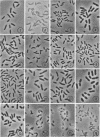Abstract
One-hundred-and-forty-five isolates of marine origin were submitted to an extensive physiological, nutritional, and morphological characterization. All strains were gram-negative, facultatively anaerobic, straight or curved rods which were motile by means of flagella. Glucose was fermented with the production of acid but no gas. Sodium but no organic growth factors were required. None of the strains were able to denitrify or fix molecular nitrogen. The results of nutritional and physiological tests were submitted to a numerical analysis. On the basis of phenotypic similarity, nine groups were established. These groups could be distinguished from one another by multiple, unrelated, phenotypic traits. Six groups which had deoxyribonucleic acid (DNA) containing 45 to 48 moles per cent guanine plus cytosine (GC) were assigned to a redefined genus Beneckea. All of the strains in this genus, when grown in liquid medium, had a single, polar flagellum. When grown on a solid medium, many strains had peritrichous flagella. Two groups were similar to previously described species and were designated B. alginolytica and B. natriegens. The remaining four groups were designated B. campbellii, B. neptuna, B. nereida, and B. pelagia. An additional group of phenotypically similar strains having the properties of the genus Beneckea was not included in the numerical analysis. These strains were readily separable from species of this genus and were designated B. parahaemolytica. Of the remaining groups, one was identified as Photobacterium fischeri. The other group (B-2) which had about 41 moles% GC content in its DNA could not be placed into existing genera.
Full text
PDF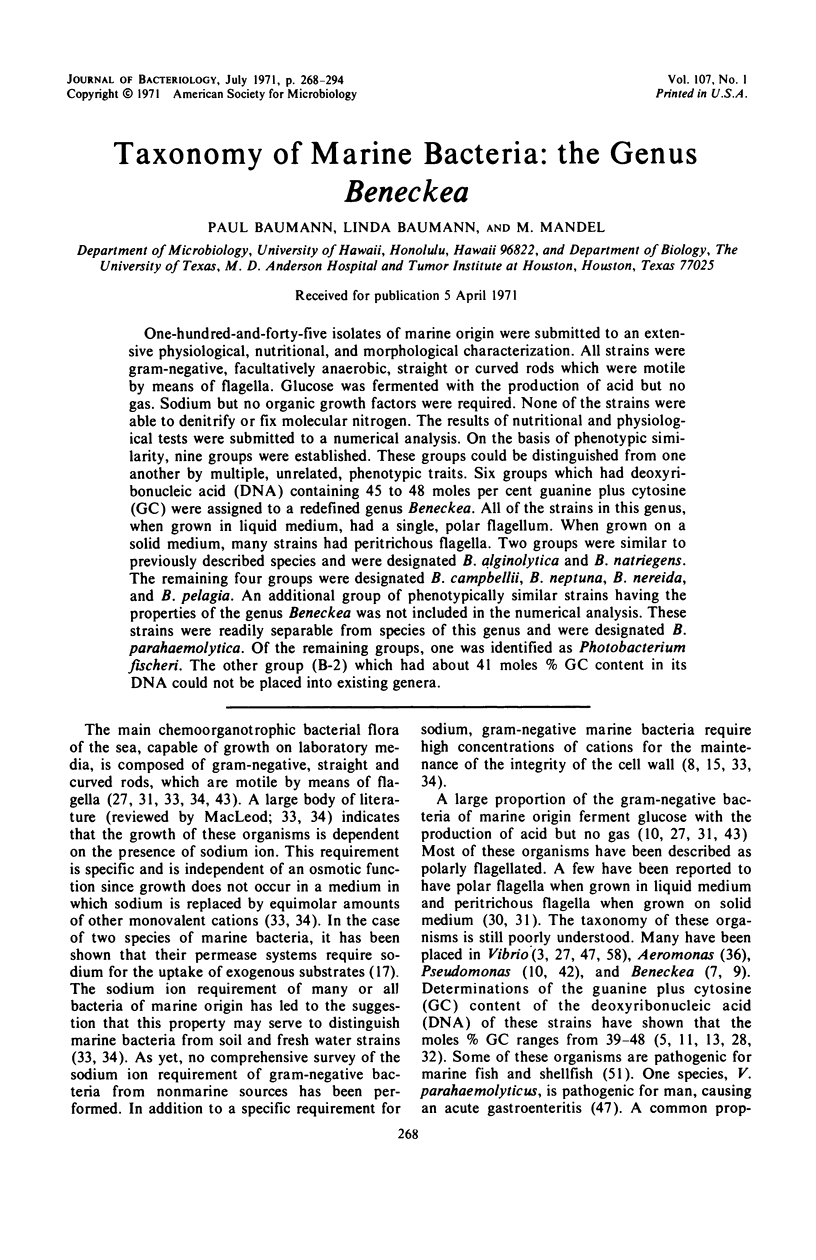
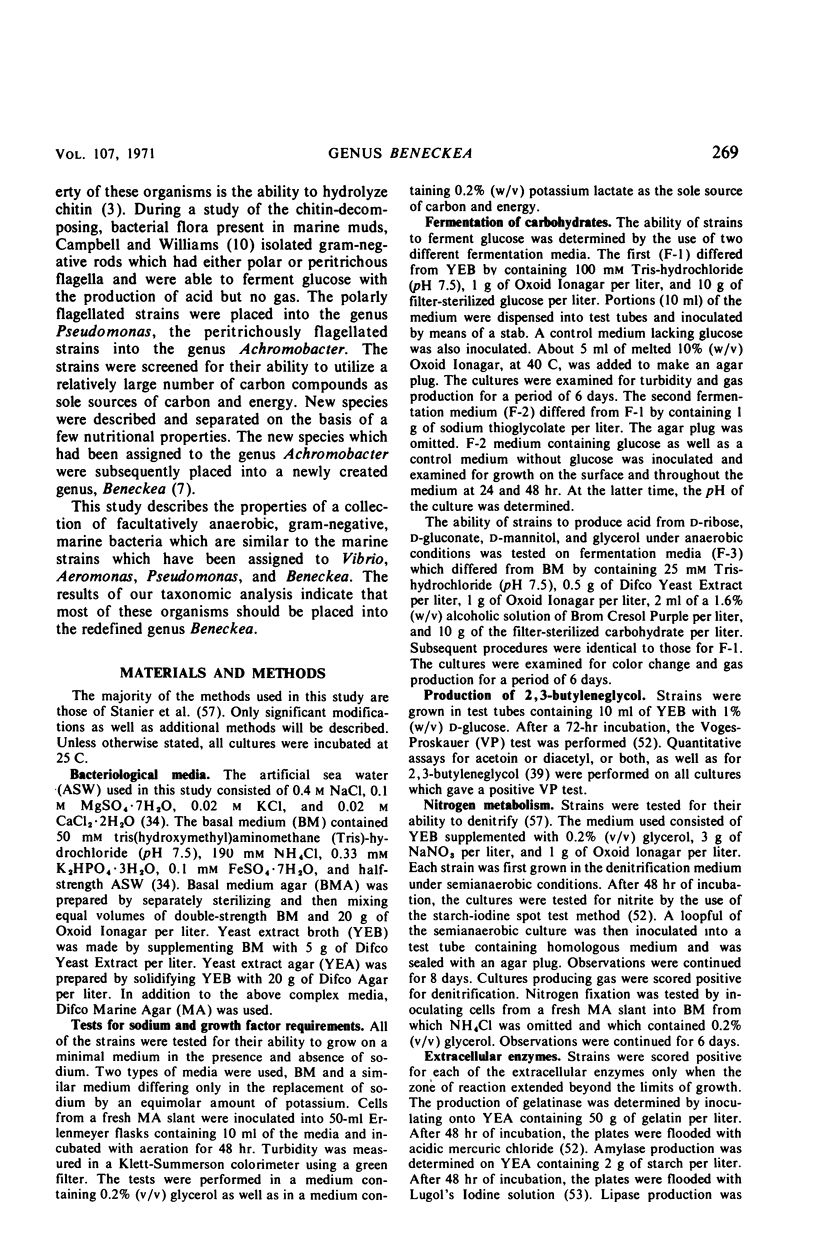
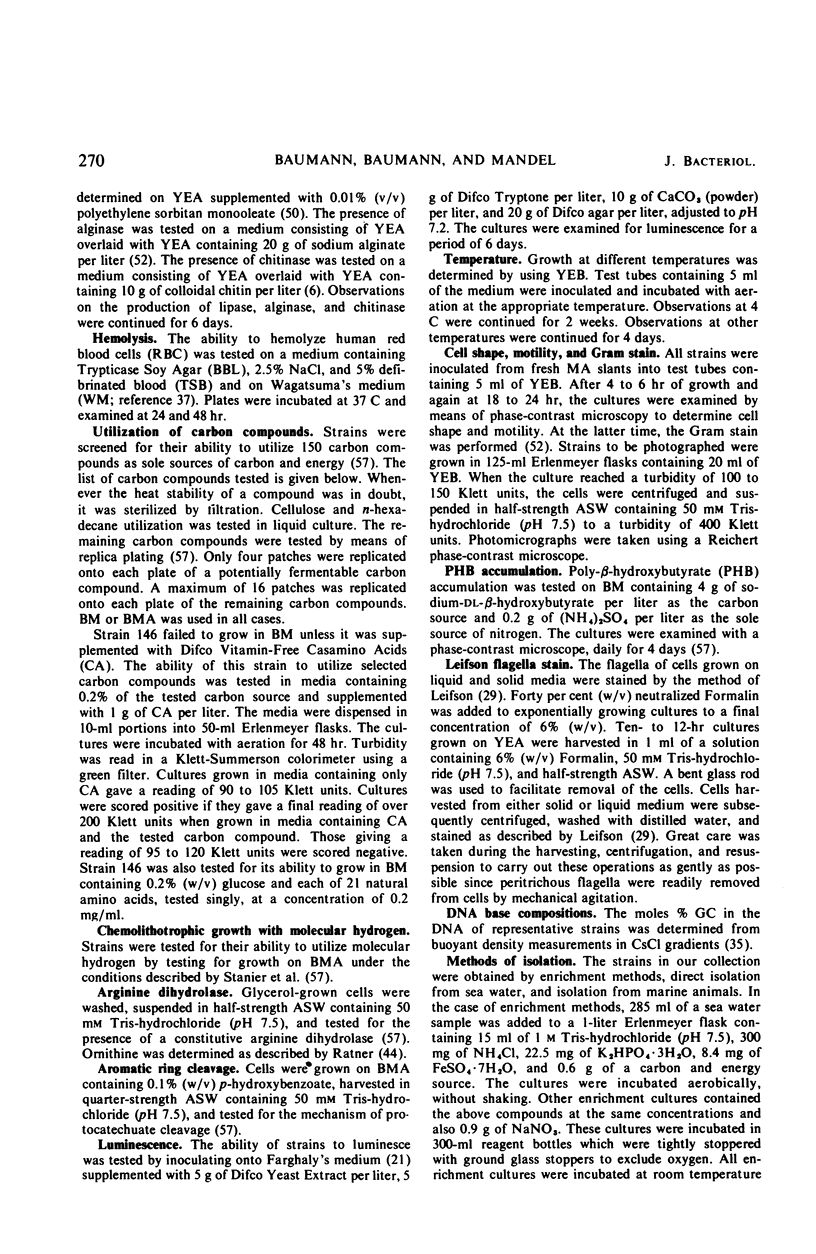
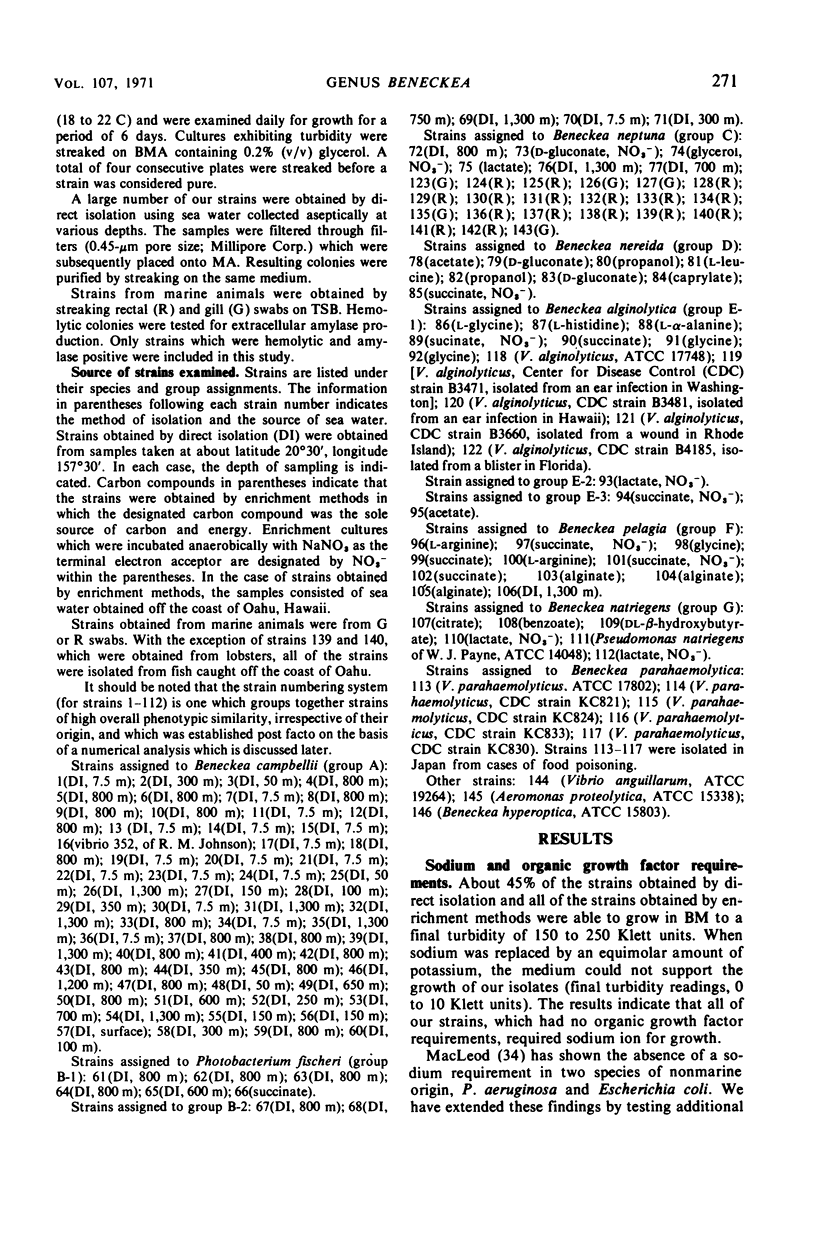
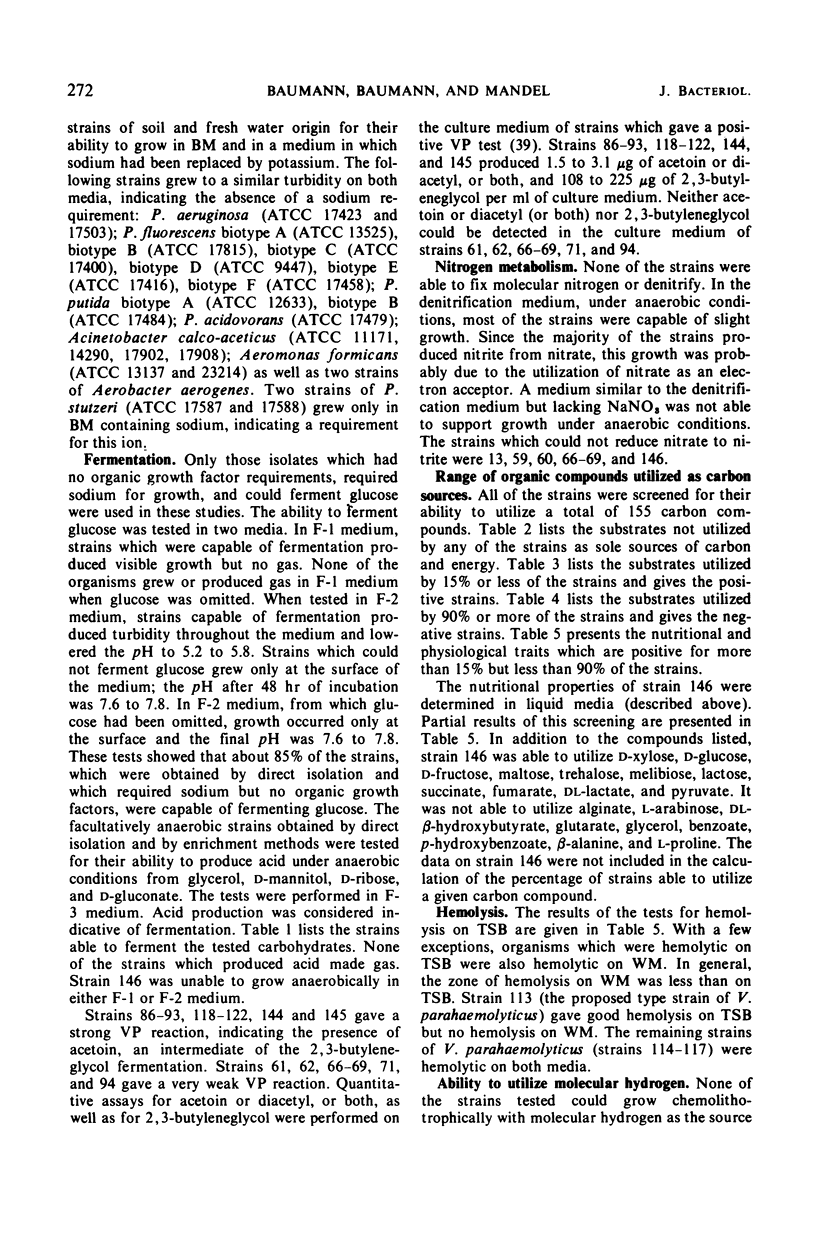
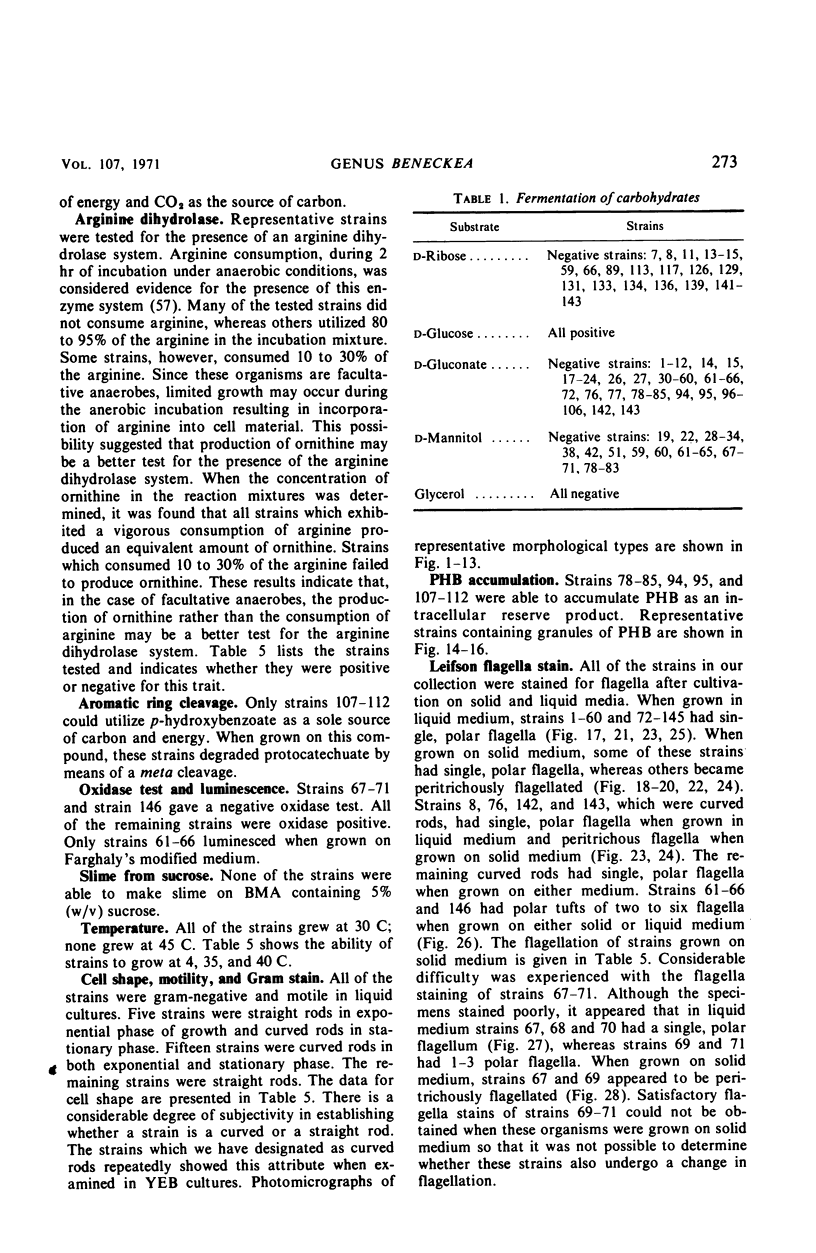
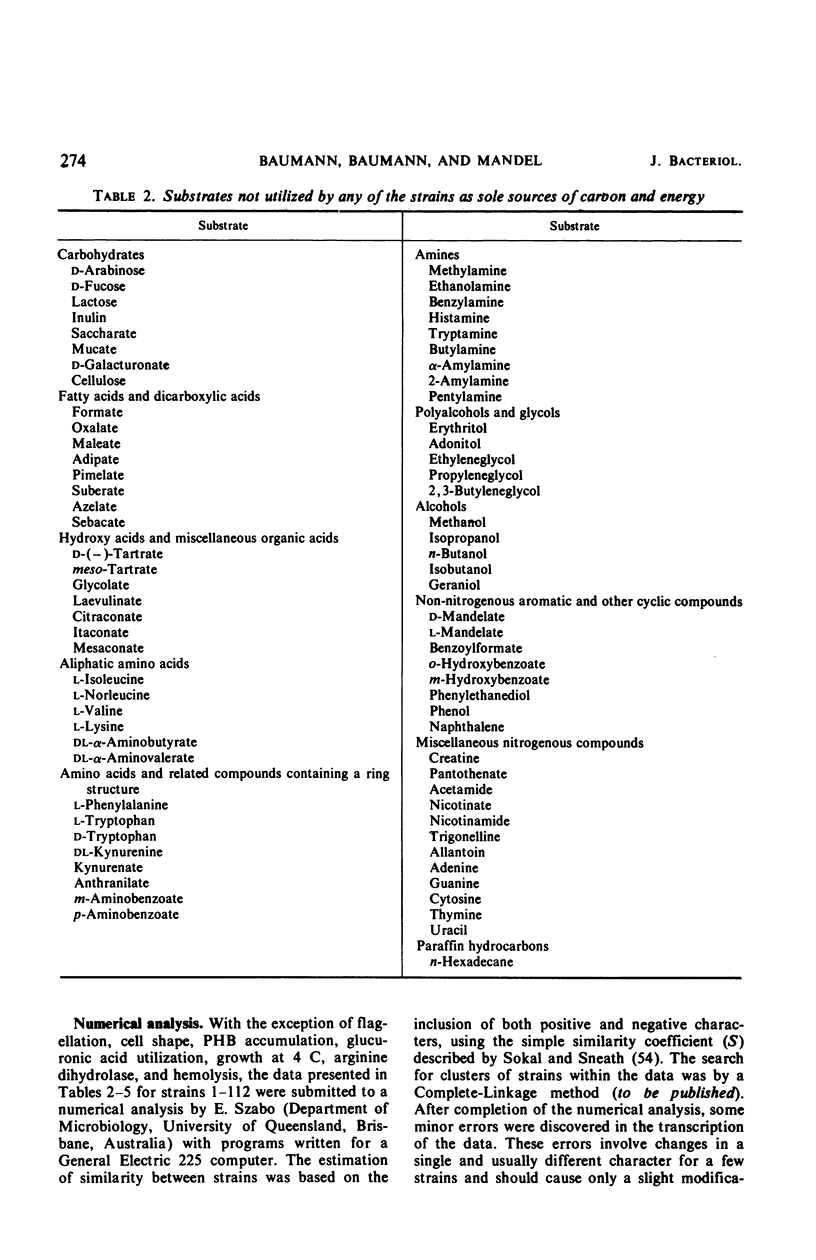
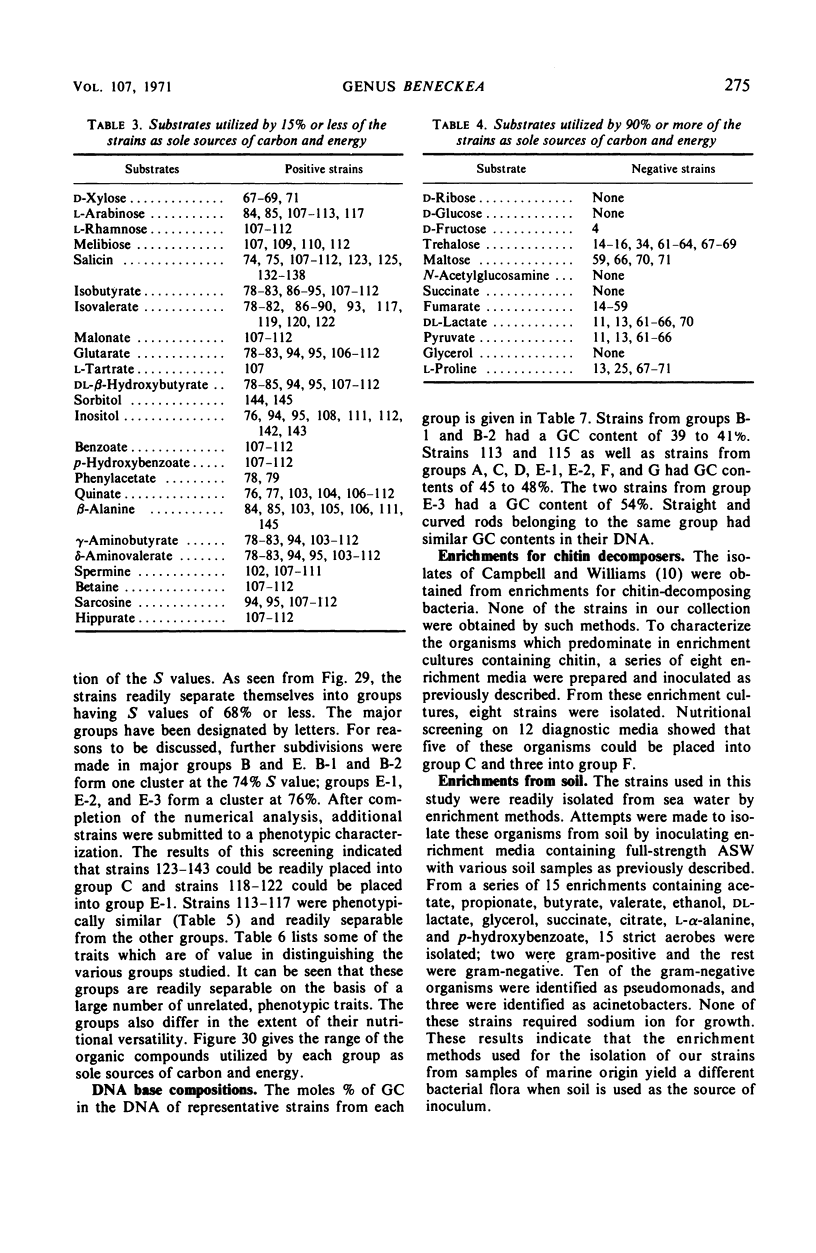
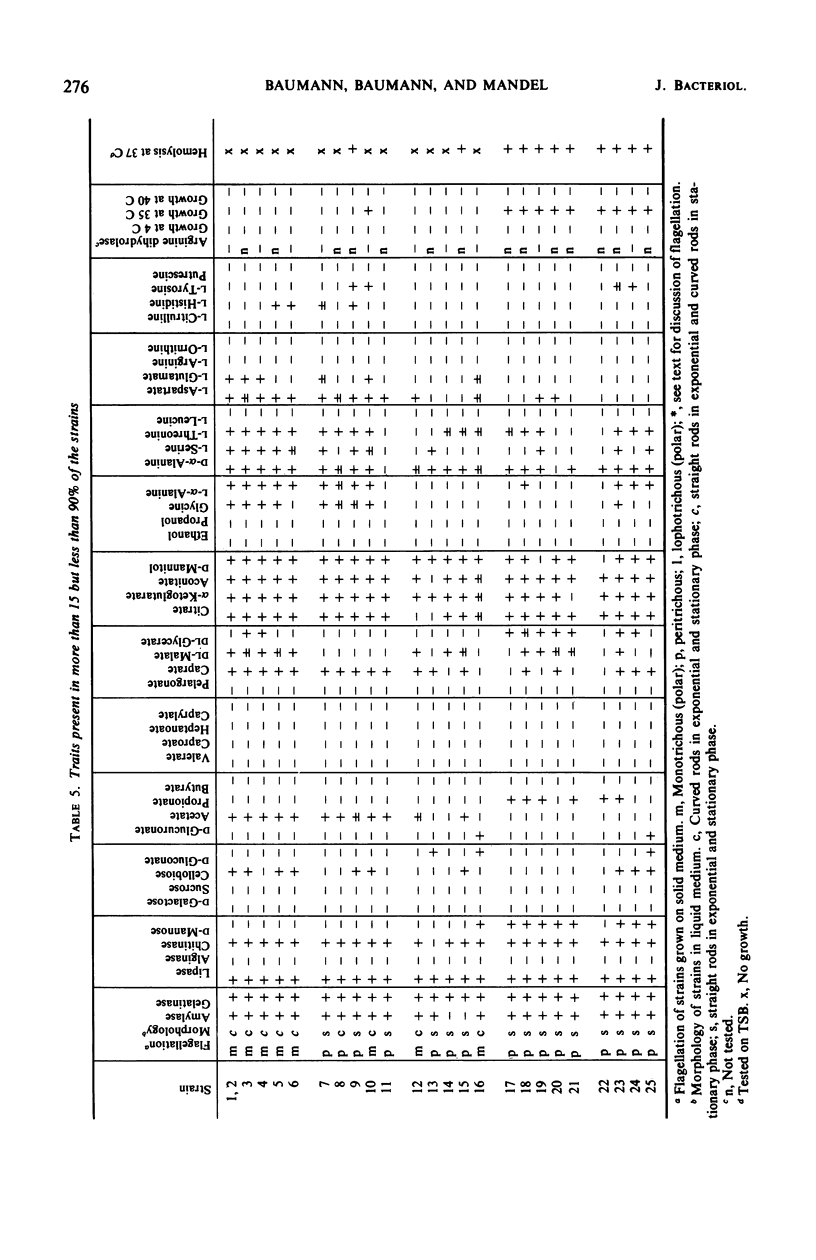
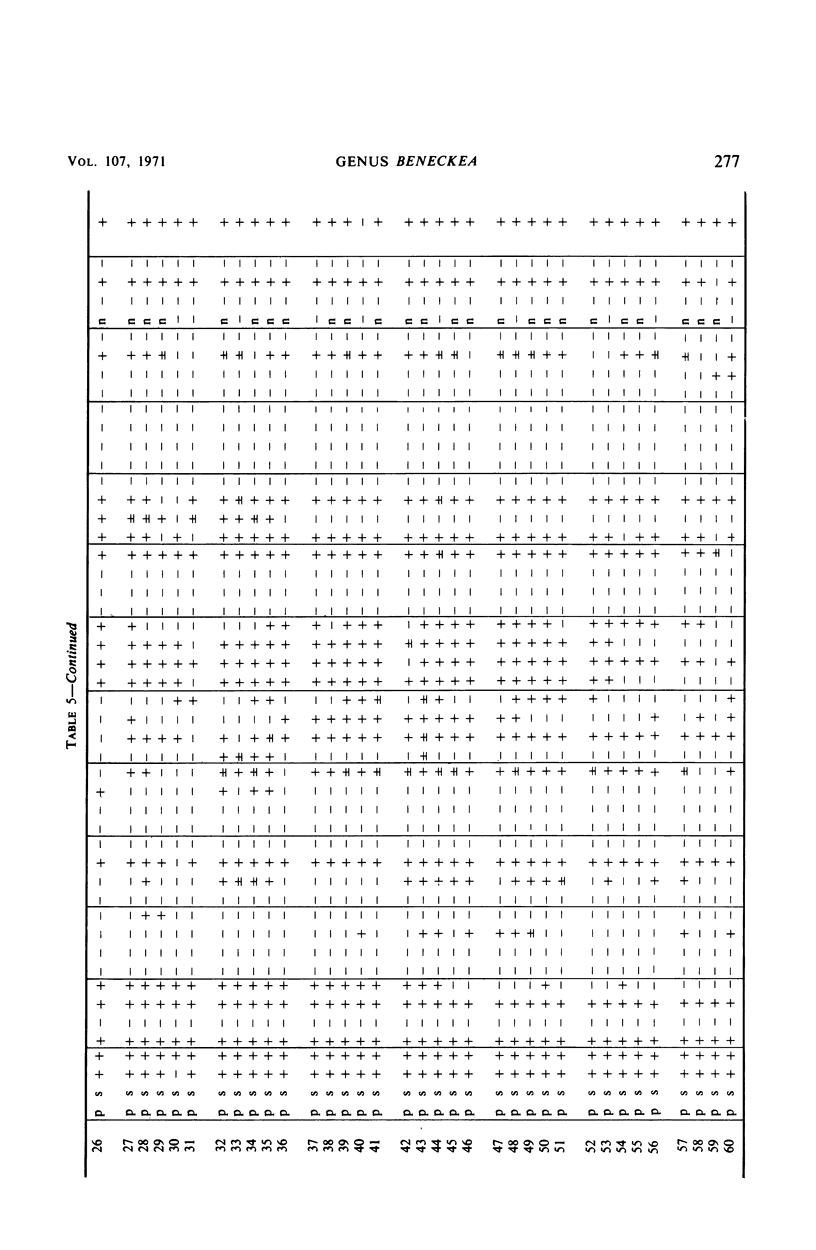
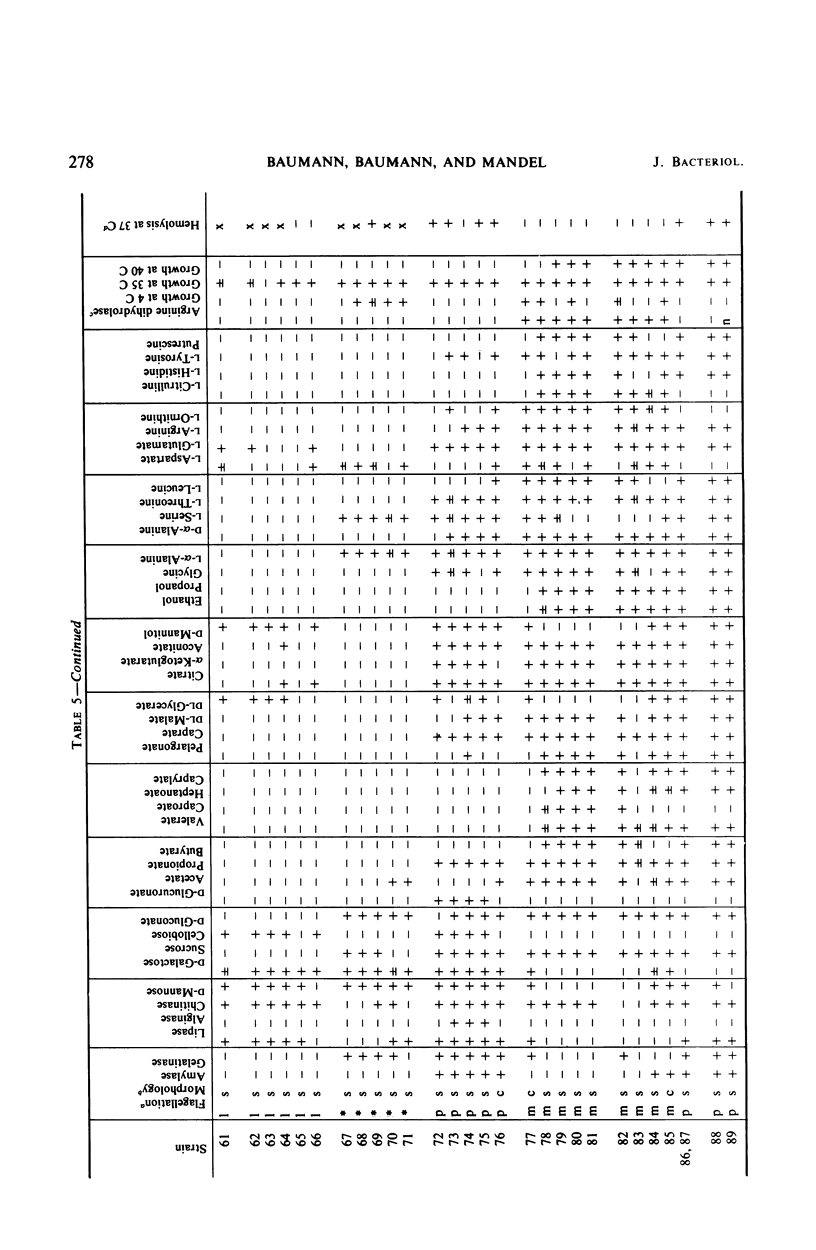
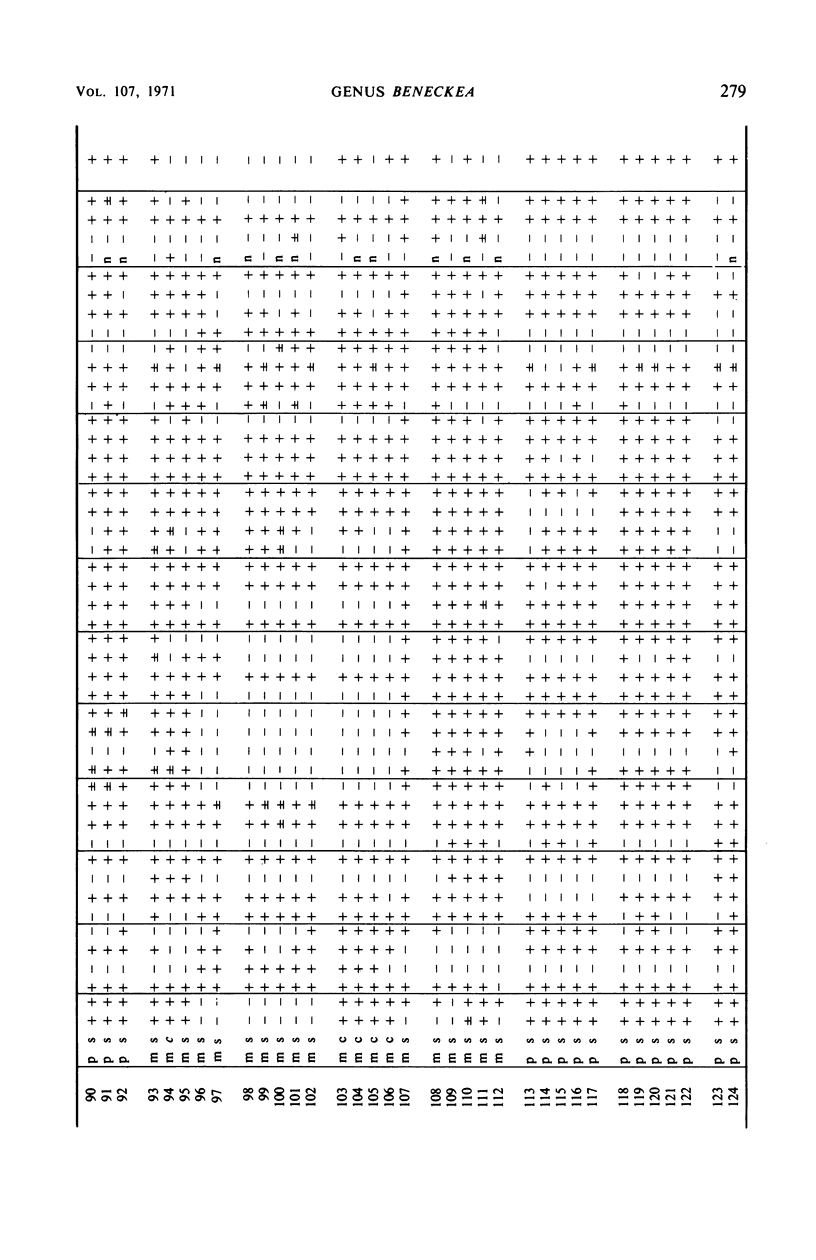
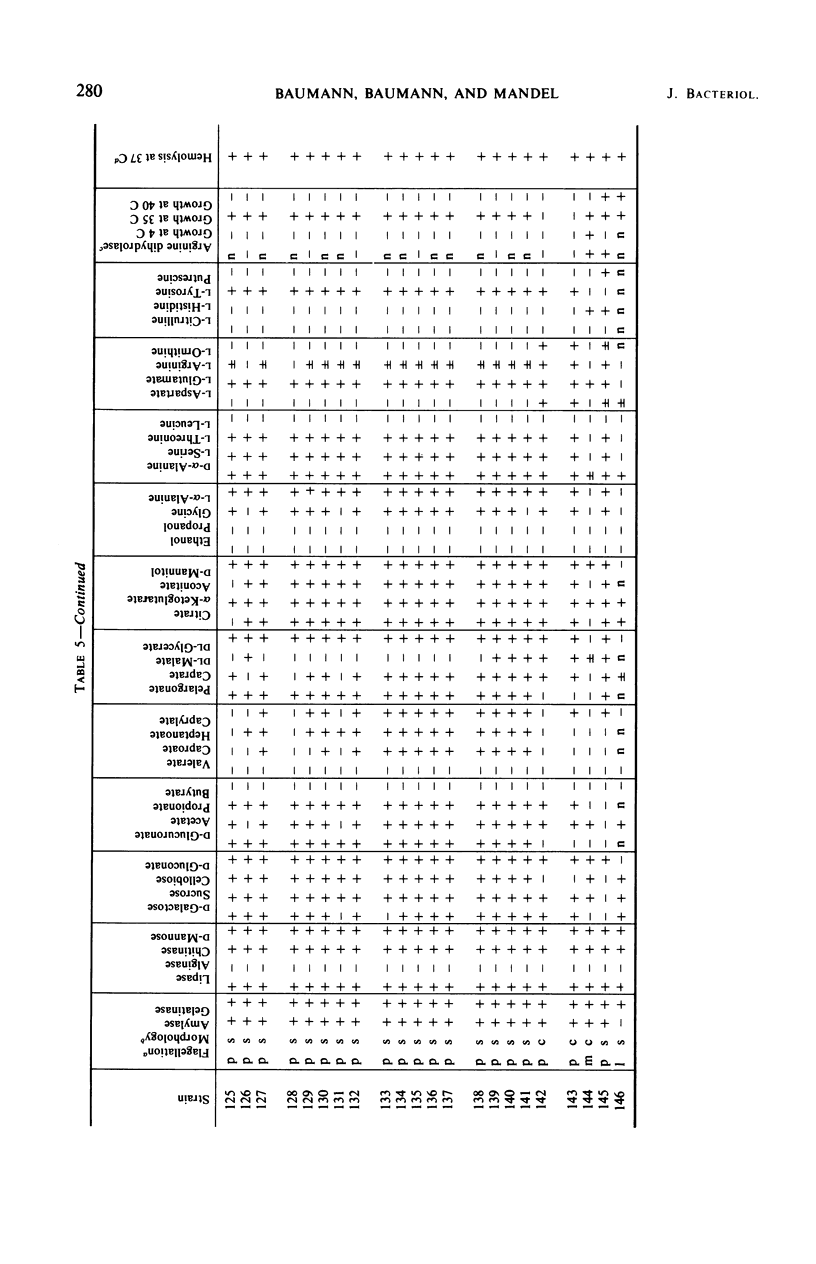
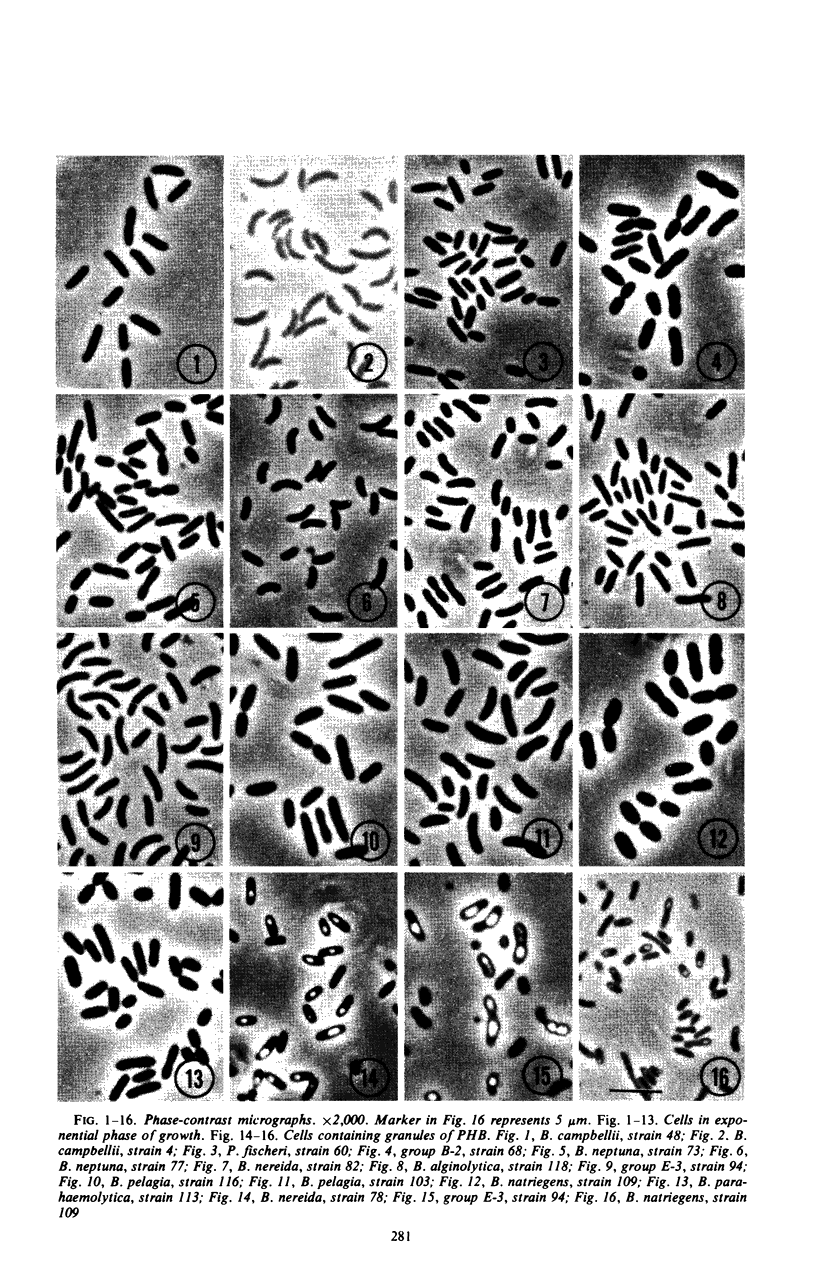
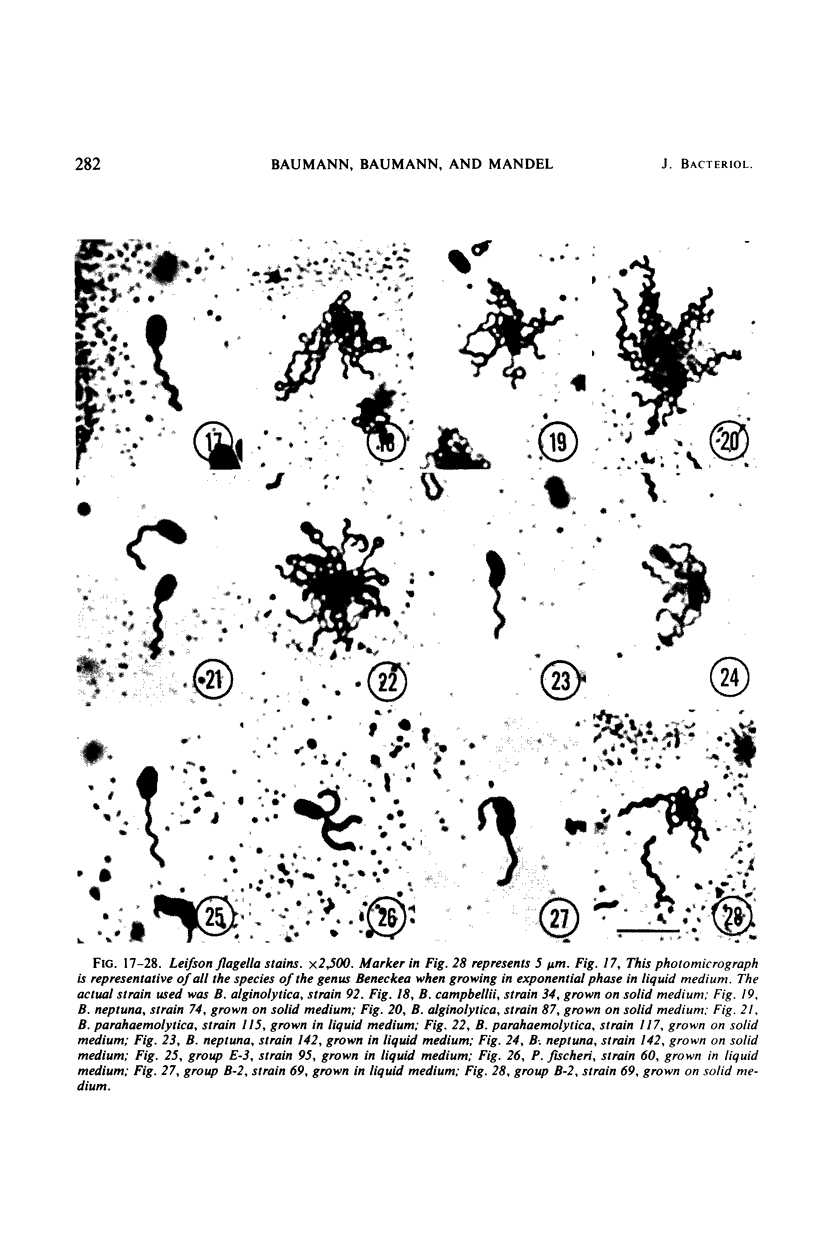
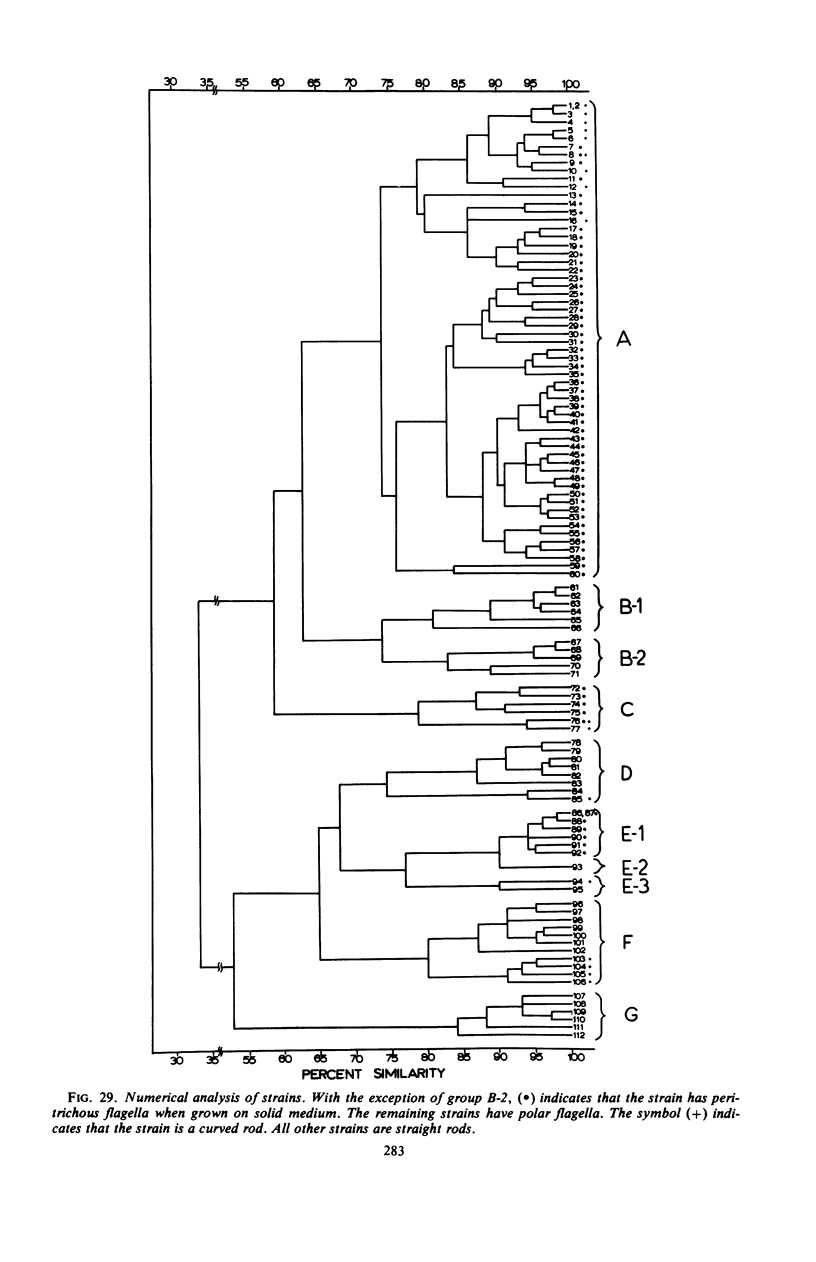
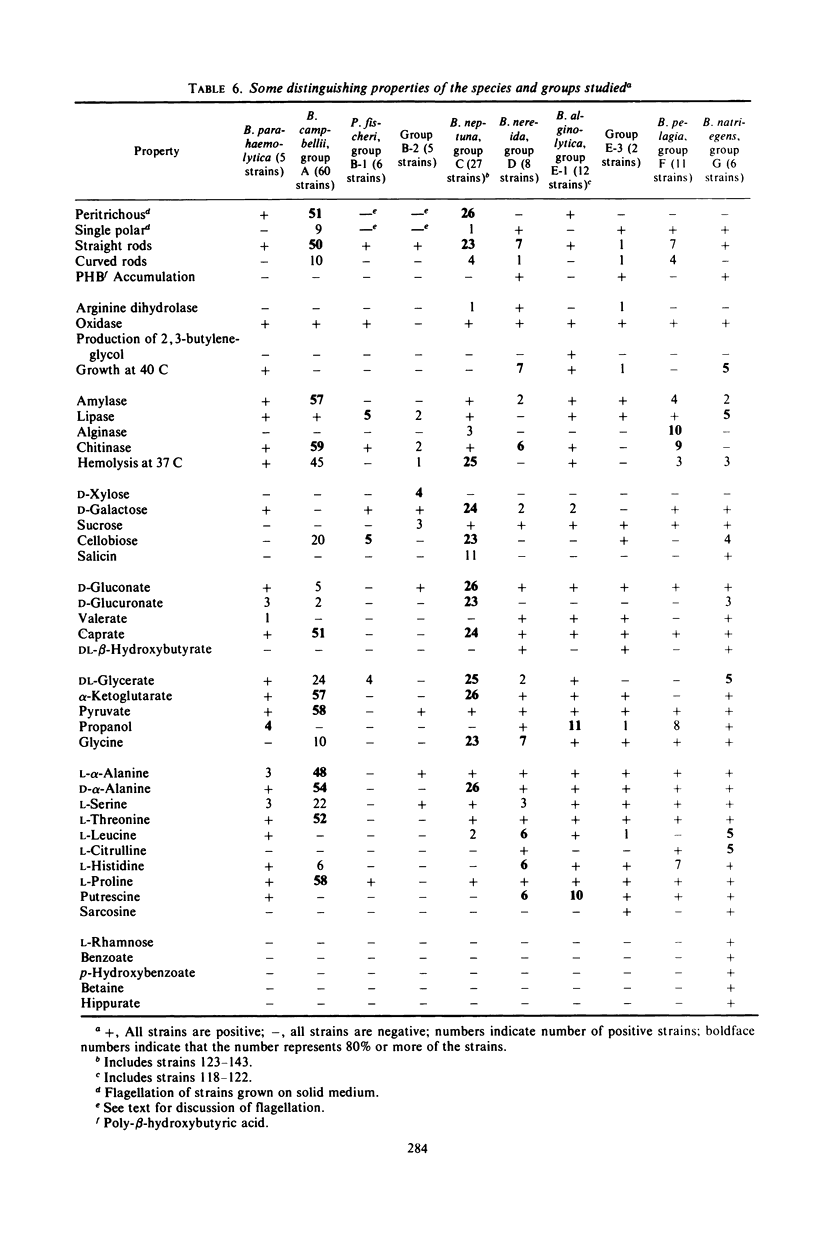
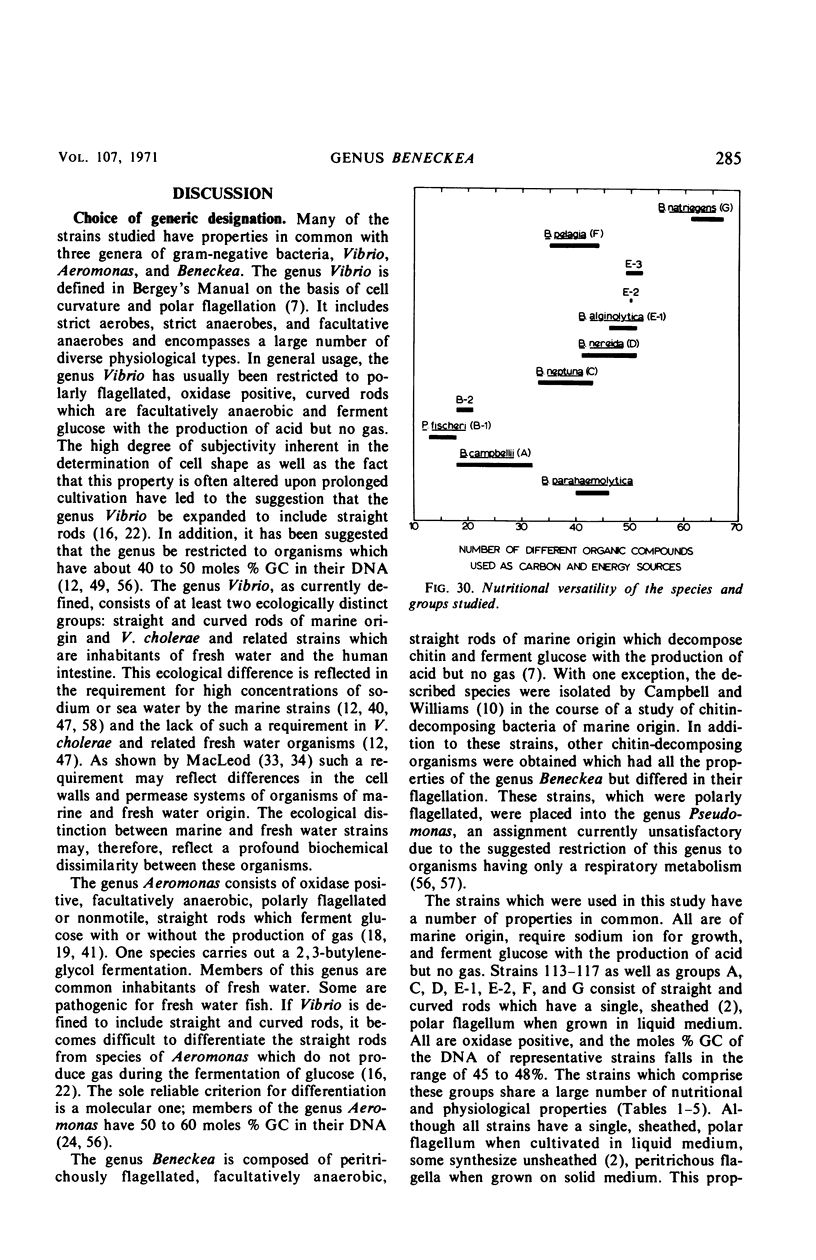
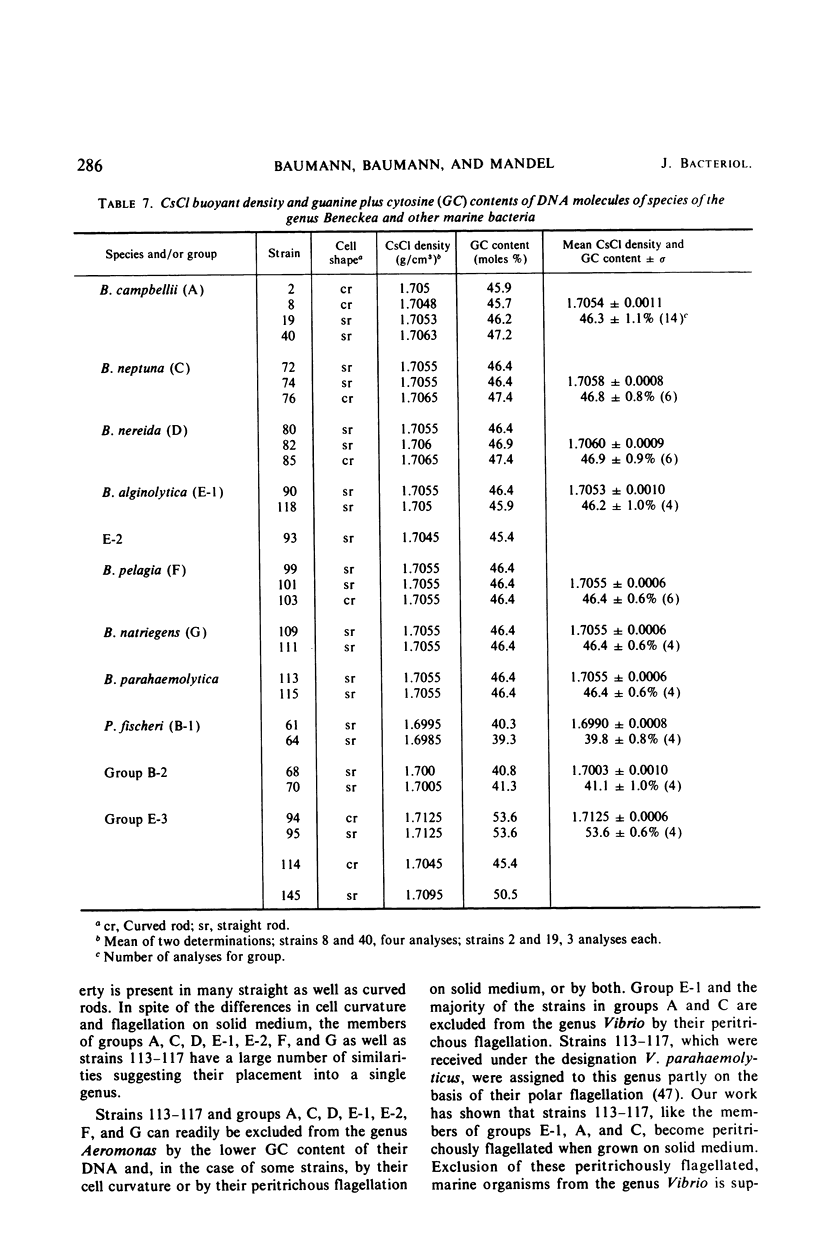
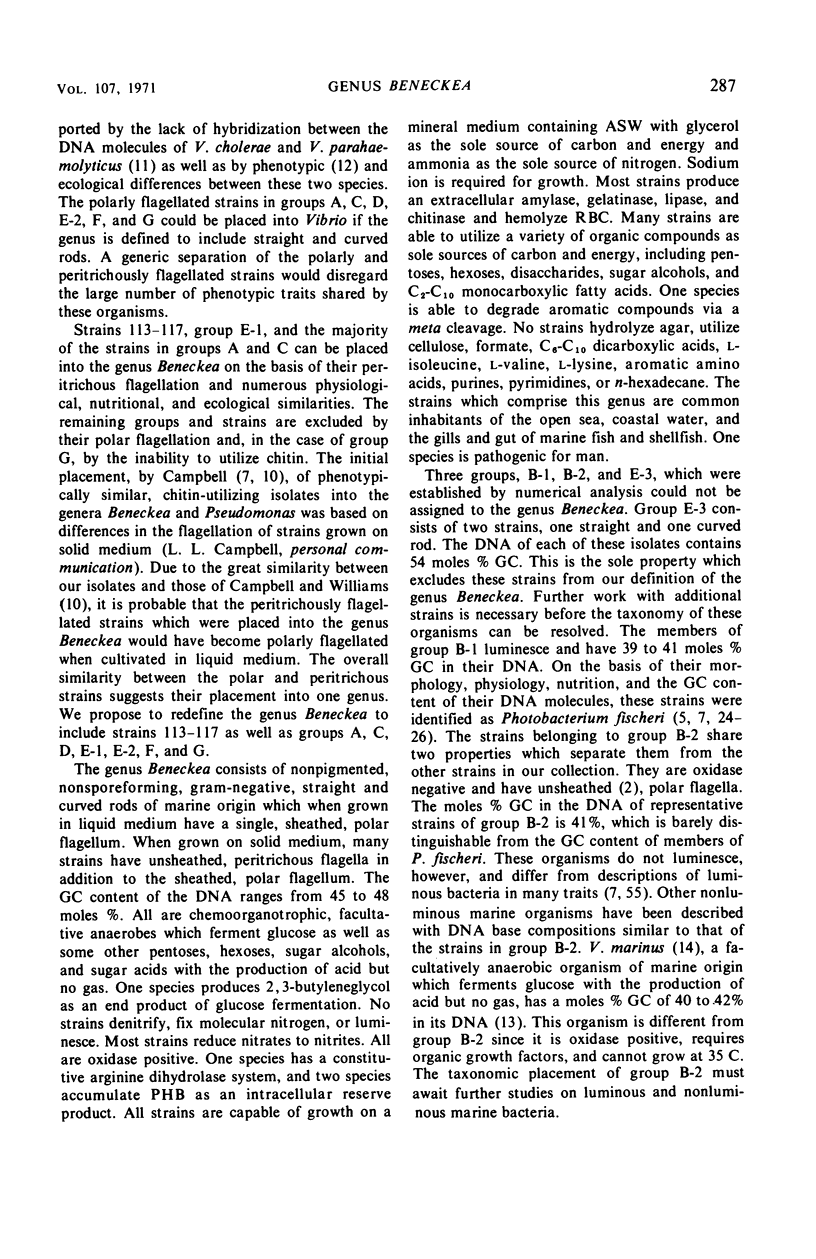
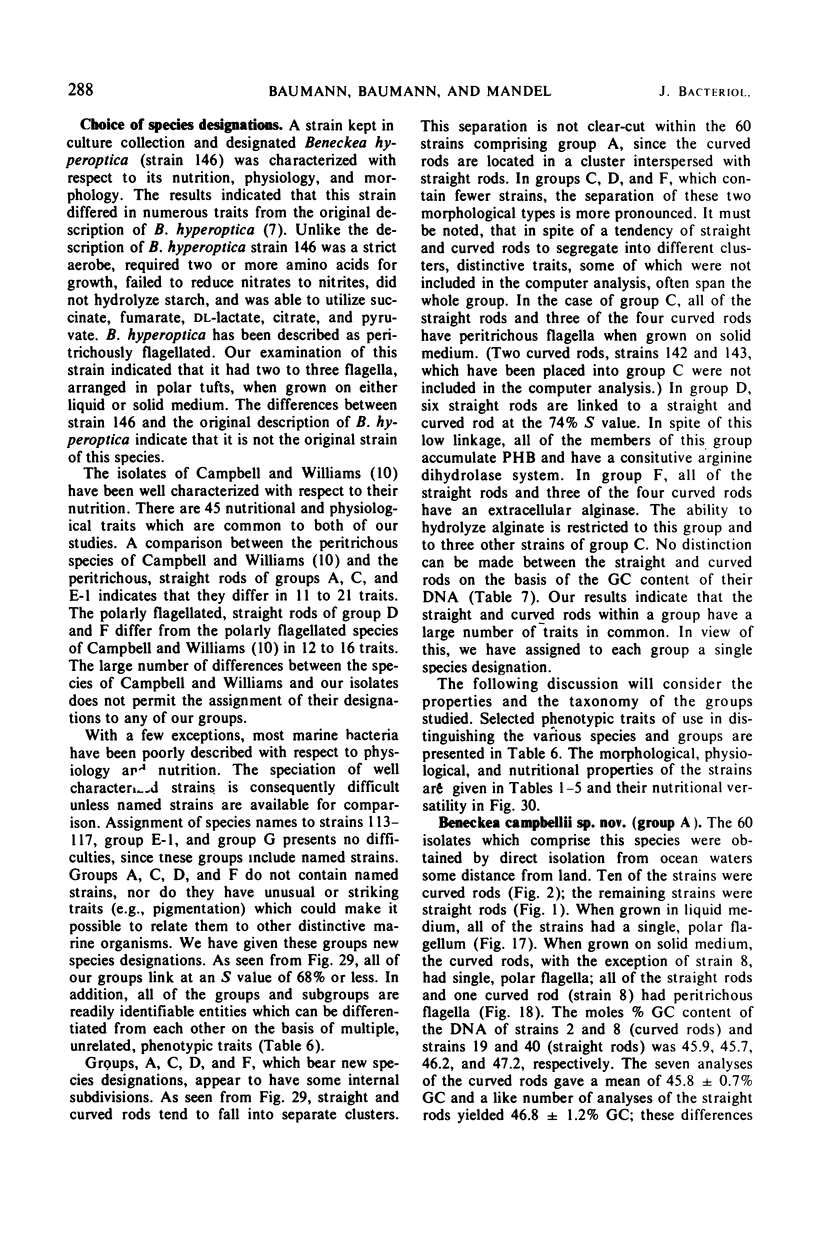
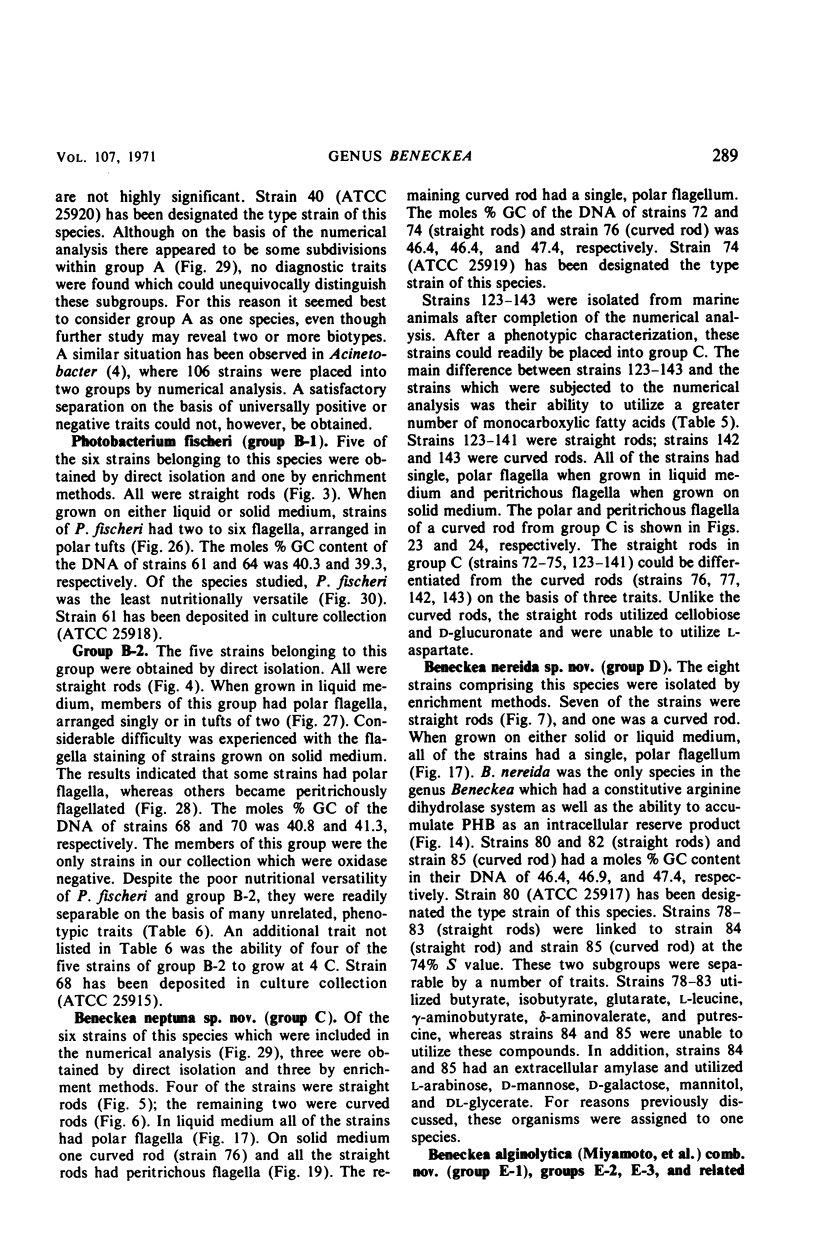
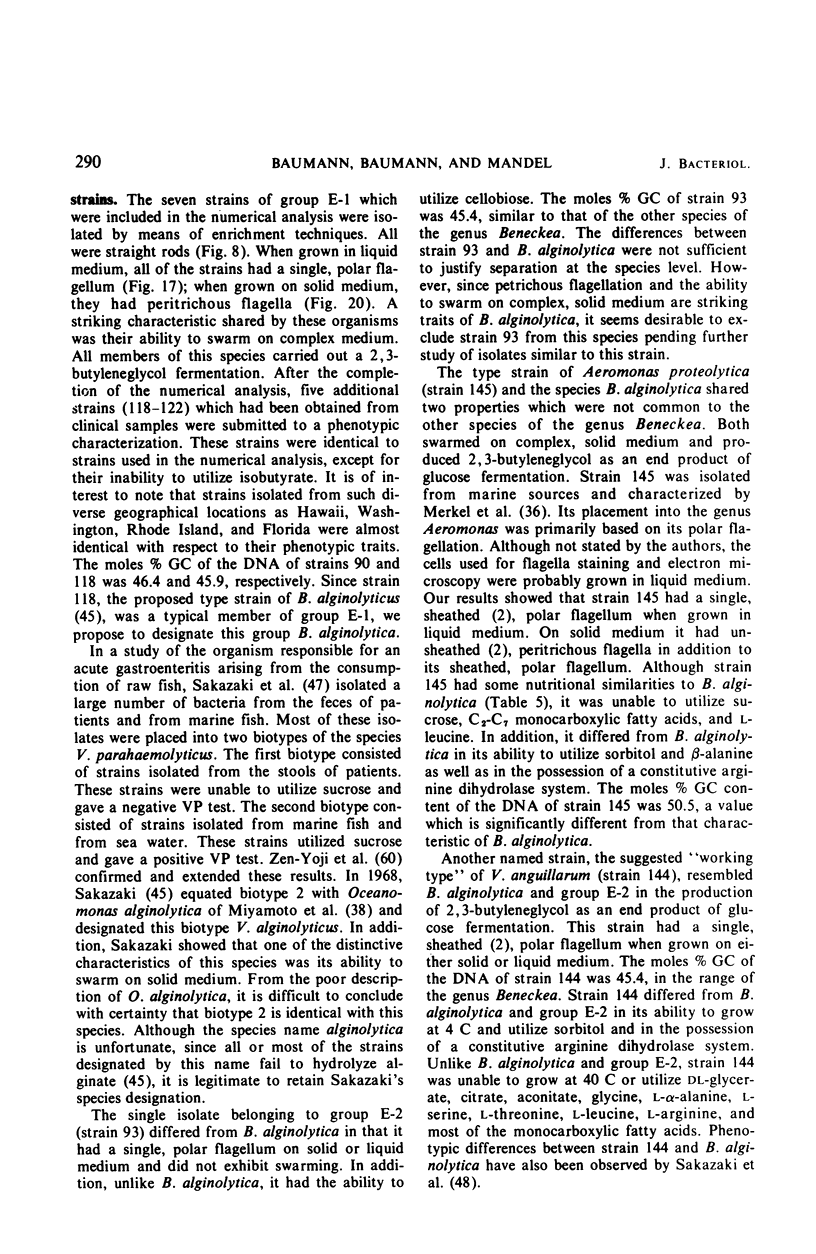
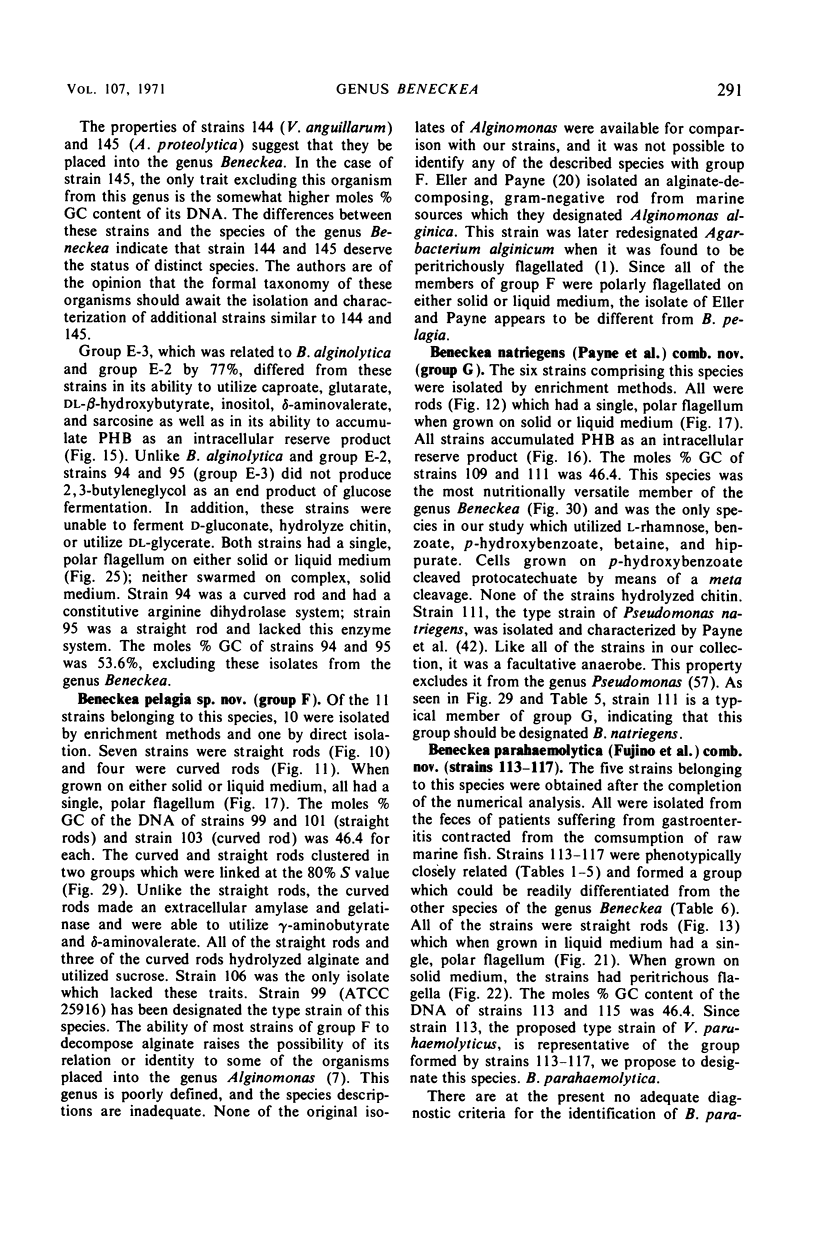
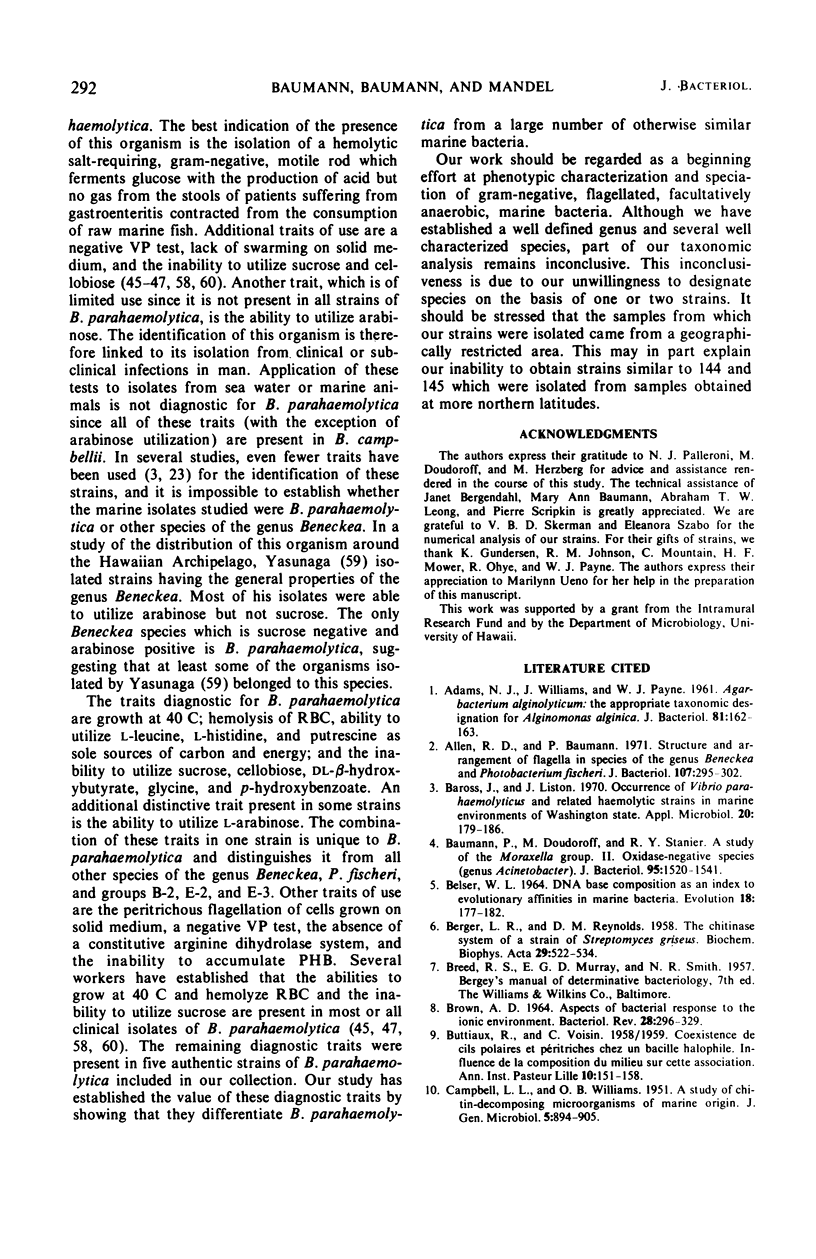
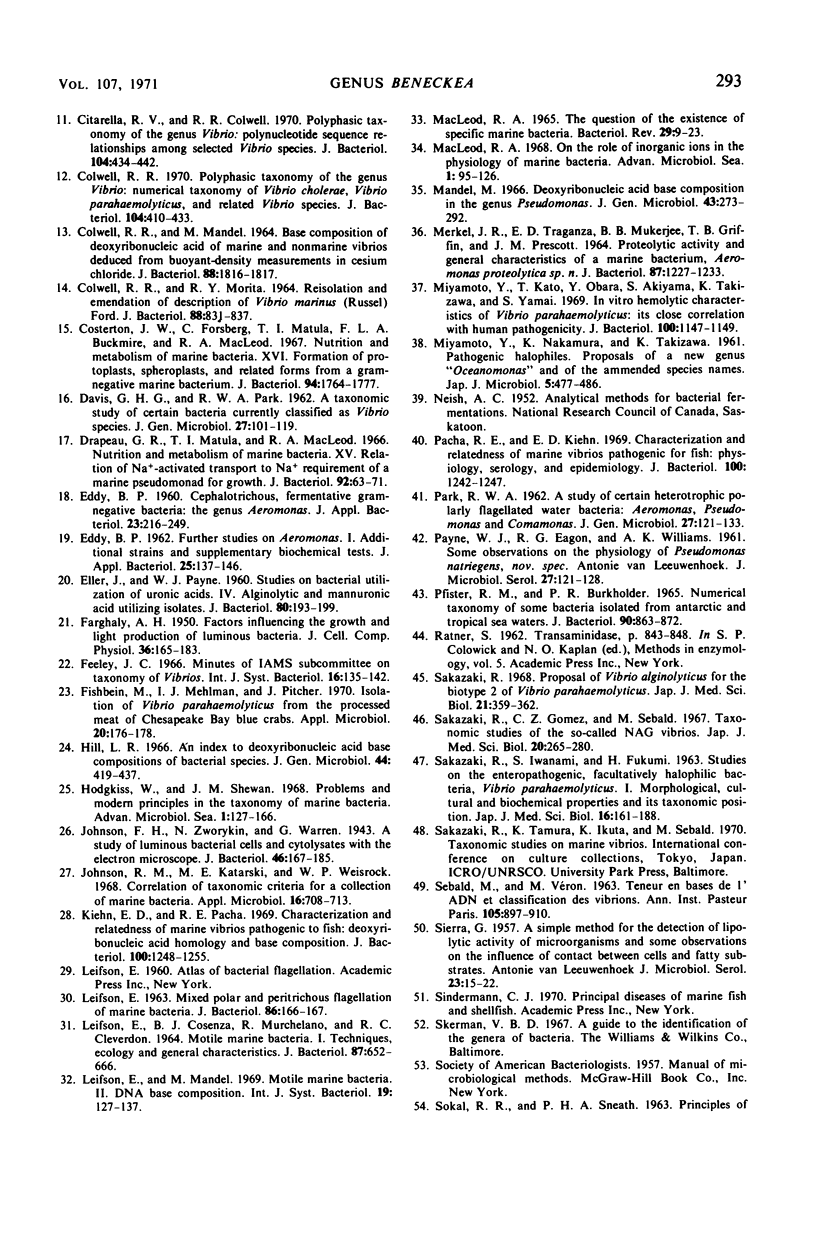
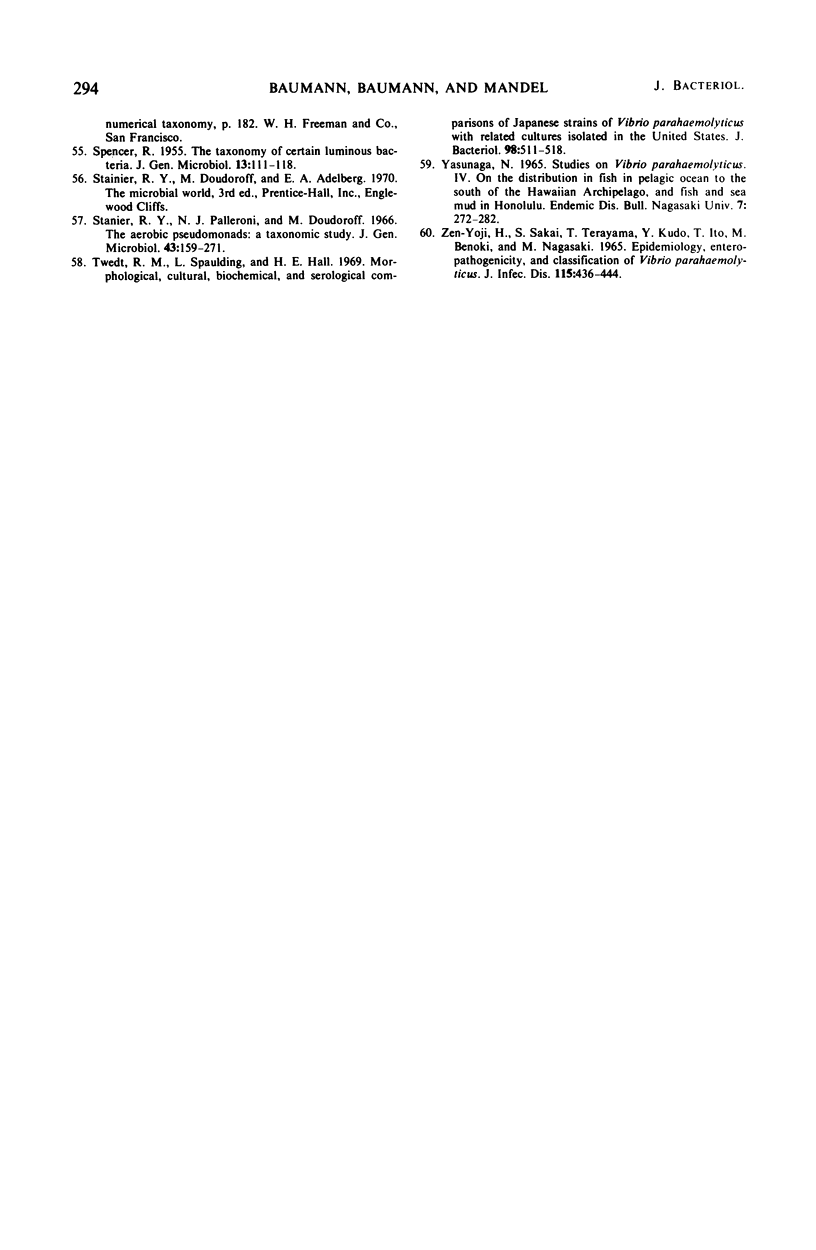
Images in this article
Selected References
These references are in PubMed. This may not be the complete list of references from this article.
- ADAMS J. N., WILLIAMS J., PAYNE W. J. Agarbacterium alginicum: the appropriate taxonomic designation for Alginomonas alginica. J Bacteriol. 1961 Jan;81:162–163. doi: 10.1128/jb.81.1.162-163.1961. [DOI] [PMC free article] [PubMed] [Google Scholar]
- Allen R. D., Baumann P. Structure and arrangement of flagella in species of the genus Beneckea and Photobacterium fischeri. J Bacteriol. 1971 Jul;107(1):295–302. doi: 10.1128/jb.107.1.295-302.1971. [DOI] [PMC free article] [PubMed] [Google Scholar]
- BERGER L. R., REYNOLDS D. M. The chitinase system of a strain of Streptomyces griseus. Biochim Biophys Acta. 1958 Sep;29(3):522–534. doi: 10.1016/0006-3002(58)90008-8. [DOI] [PubMed] [Google Scholar]
- BROWN A. D. ASPECTS OF BACTERIAL RESPONSE TO THE IONIC ENVIRONMENT. Bacteriol Rev. 1964 Sep;28:296–329. doi: 10.1128/br.28.3.296-329.1964. [DOI] [PMC free article] [PubMed] [Google Scholar]
- Baross J., Liston J. Occurrence of Vibrio parahaemolyticus and related hemolytic vibrios in marine environments of Washington State. Appl Microbiol. 1970 Aug;20(2):179–186. doi: 10.1128/am.20.2.179-186.1970. [DOI] [PMC free article] [PubMed] [Google Scholar]
- CAMPBELL L. L., WILLIAMS O. B. A study of chitin-decomposing micro-organisms of marine origin. J Gen Microbiol. 1951 Nov;5(5 Suppl):894–905. doi: 10.1099/00221287-5-5-894. [DOI] [PubMed] [Google Scholar]
- COLWELL R. R., MANDEL M. BASE COMPOSITION OF DEOXYRIBONUCLEIC ACID OF MARINE AND NONMARINE VIBRIOS DEDUCED FROM BUOYANT-DENSITY MEASUREMENTS IN CESIUM CHLORIDE. J Bacteriol. 1964 Dec;88:1816–1817. doi: 10.1128/jb.88.6.1816-1817.1964. [DOI] [PMC free article] [PubMed] [Google Scholar]
- COLWELL R. R., MORITA R. Y. REISOLATION AND EMENDATION OF DESCRIPTION OF VIBRIO MARINUS (RUSSELL) FORD. J Bacteriol. 1964 Oct;88:831–837. doi: 10.1128/jb.88.4.831-837.1964. [DOI] [PMC free article] [PubMed] [Google Scholar]
- Citarella R. V., Colwell R. R. Polyphasic taxonomy of the genus Vibrio: polynucleotide sequence relationships among selected Vibrio species. J Bacteriol. 1970 Oct;104(1):434–442. doi: 10.1128/jb.104.1.434-442.1970. [DOI] [PMC free article] [PubMed] [Google Scholar]
- Colwell R. R. Polyphasic taxonomy of the genus vibrio: numerical taxonomy of Vibrio cholerae, Vibrio parahaemolyticus, and related Vibrio species. J Bacteriol. 1970 Oct;104(1):410–433. doi: 10.1128/jb.104.1.410-433.1970. [DOI] [PMC free article] [PubMed] [Google Scholar]
- Costerton J. W., Forsberg C., Matula T. I., Buckmire F. L., MacLeod R. A. Nutrition and metabolism of marine bacteria. XVI. Formation of protoplasts, spheroplasts, and related forms from a gram-negative marine bacterium. J Bacteriol. 1967 Nov;94(5):1764–1777. doi: 10.1128/jb.94.5.1764-1777.1967. [DOI] [PMC free article] [PubMed] [Google Scholar]
- DAVIS G. H., PARK R. W. A taxonomic study of certain bacteria currently classified as Vibrio species. J Gen Microbiol. 1962 Jan;27:101–119. doi: 10.1099/00221287-27-1-101. [DOI] [PubMed] [Google Scholar]
- Drapeau G. R., Matula T. I., MacLeod R. A. Nutrition and metabolism of marine bacteria. XV. Relation of Na+-activated transport to the Na+ requirement of a marine pseudomonad for growth. J Bacteriol. 1966 Jul;92(1):63–71. doi: 10.1128/jb.92.1.63-71.1966. [DOI] [PMC free article] [PubMed] [Google Scholar]
- ELLER J., PAYNE W. J. Studies on bacterial utilization of uronic acids. 4. Alginolytic and mannuronic acid oxidizing isolates. J Bacteriol. 1960 Aug;80:193–199. doi: 10.1128/jb.80.2.193-199.1960. [DOI] [PMC free article] [PubMed] [Google Scholar]
- FARGHALY A. H. Factors influencing the growth and light production of luminous bacteria. J Cell Physiol. 1950 Oct;36(2):165–183. doi: 10.1002/jcp.1030360205. [DOI] [PubMed] [Google Scholar]
- Fishbein M., Mehlman I. J., Pitcher J. Isolation of Vibrio parahaemolyticus from the processed meat of Chesapeake Bay blue crabs. Appl Microbiol. 1970 Aug;20(2):176–178. doi: 10.1128/am.20.2.176-178.1970. [DOI] [PMC free article] [PubMed] [Google Scholar]
- Hill L. R. An index to deoxyribonucleic acid base compositions of bacterial species. J Gen Microbiol. 1966 Sep;44(3):419–437. doi: 10.1099/00221287-44-3-419. [DOI] [PubMed] [Google Scholar]
- Johnson F. H., Zworykin N., Warren G. A Study of Luminous Bacterial Cells and Cytolysates with the Electron Microscope. J Bacteriol. 1943 Aug;46(2):167–185. doi: 10.1128/jb.46.2.167-185.1943. [DOI] [PMC free article] [PubMed] [Google Scholar]
- Johnson R. M., Katarski M. E., Weisrock W. P. Correlation of taxonomic criteria for a collection of marine bacteria. Appl Microbiol. 1968 May;16(5):708–713. doi: 10.1128/am.16.5.708-713.1968. [DOI] [PMC free article] [PubMed] [Google Scholar]
- Kiehn E. D., Pacha R. E. Characterization and relatedness of marine vibrios pathogenic to fish: deoxyribonucleic acid homology and base composition. J Bacteriol. 1969 Dec;100(3):1248–1255. doi: 10.1128/jb.100.3.1248-1255.1969. [DOI] [PMC free article] [PubMed] [Google Scholar]
- LEIFSON E., COSENZA B. J., MURCHELANO R., CLEVERDON R. C. MOTILE MARINE BACTERIA. I. TECHNIQUES, ECOLOGY, AND GENERAL CHARACTERISTICS. J Bacteriol. 1964 Mar;87:652–666. doi: 10.1128/jb.87.3.652-666.1964. [DOI] [PMC free article] [PubMed] [Google Scholar]
- LEIFSON E. MIXED POLAR AND PERITRICHOUS FLAGELLATION OF MARINE BACTERIA. J Bacteriol. 1963 Jul;86:166–167. doi: 10.1128/jb.86.1.166-167.1963. [DOI] [PMC free article] [PubMed] [Google Scholar]
- MACLEOD R. A. THE QUESTION OF THE EXISTENCE OF SPECIFIC MARINE BACTERIA. Bacteriol Rev. 1965 Mar;29:9–24. [PMC free article] [PubMed] [Google Scholar]
- Mandel M. Deoxyribonucleic acid base composition in the genus Pseudomonas. J Gen Microbiol. 1966 May;43(2):273–292. doi: 10.1099/00221287-43-2-273. [DOI] [PubMed] [Google Scholar]
- Merkel J. R., Traganza E. D., Mukherjee B. B., Griffin T. B., Prescott J. M. Proteolytic activity and general characteristics of a marine bacterium, Aeromonas proteolytica sp. N. J Bacteriol. 1964 May;87(5):1227–1233. doi: 10.1128/jb.87.5.1227-1233.1964. [DOI] [PMC free article] [PubMed] [Google Scholar]
- Miyamoto Y., Kato T., Obara Y., Akiyama S., Takizawa K., Yamai S. In vitro hemolytic characteristic of Vibrio parahaemolyticus: its close correlation with human pathogenicity. J Bacteriol. 1969 Nov;100(2):1147–1149. doi: 10.1128/jb.100.2.1147-1149.1969. [DOI] [PMC free article] [PubMed] [Google Scholar]
- PARK R. W. A study of certain heterotrophic polarly flagellate water bacteria: Aeromonas, Pseudomonas and Comamonas. J Gen Microbiol. 1962 Jan;27:121–133. doi: 10.1099/00221287-27-1-121. [DOI] [PubMed] [Google Scholar]
- PAYNE W. J., EAGON R. G., WILLIAMS A. K. Some observations on the physiology of Pseudomonas natriegens nov. spec. Antonie Van Leeuwenhoek. 1961;27:121–128. doi: 10.1007/BF02538432. [DOI] [PubMed] [Google Scholar]
- Pacha R. E., Kiehn E. D. Characterization and relatedness of marine vibrios pathogenic to fish: physiology, serology, and epidemiology. J Bacteriol. 1969 Dec;100(3):1242–1247. doi: 10.1128/jb.100.3.1242-1247.1969. [DOI] [PMC free article] [PubMed] [Google Scholar]
- Pfister R. M., Burkholder P. R. Numerical taxonomy of some bacteria isolated from antarctic and tropical seawaters. J Bacteriol. 1965 Oct;90(4):863–872. doi: 10.1128/jb.90.4.863-872.1965. [DOI] [PMC free article] [PubMed] [Google Scholar]
- SAKAZAKI R., IWANAMI S., FUKUMI H. STUDIES ON THE ENTEROPATHOGENIC, FACULTATIVELY HALOPHILIC BACTERIA, VIBRIO PARAHAEMOLYTICUS. I. MORPHOLOGICAL, CULTURAL AND BIOCHEMICAL PROPERTIES AND ITS TAXONOMICAL POSITION. Jpn J Med Sci Biol. 1963 Aug;16:161–188. doi: 10.7883/yoken1952.16.161. [DOI] [PubMed] [Google Scholar]
- SEBALD M., VERON M. TENEUR EN BASES DE L'ADN ET CLASSIFICATION DES VIBRIONS. Ann Inst Pasteur (Paris) 1963 Nov;105:897–910. [PubMed] [Google Scholar]
- SIERRA G. A simple method for the detection of lipolytic activity of micro-organisms and some observations on the influence of the contact between cells and fatty substrates. Antonie Van Leeuwenhoek. 1957;23(1):15–22. doi: 10.1007/BF02545855. [DOI] [PubMed] [Google Scholar]
- SPENCER R. The taxonomy of certain luminous bacteria. J Gen Microbiol. 1955 Aug;13(1):111–118. doi: 10.1099/00221287-13-1-111. [DOI] [PubMed] [Google Scholar]
- Sakazaki R. Proposal of Vibrio alginolyticus for the biotype 2 of Vibrio parahaemolyticus. Jpn J Med Sci Biol. 1968 Oct;21(5):359–362. doi: 10.7883/yoken1952.21.359. [DOI] [PubMed] [Google Scholar]
- Stanier R. Y., Palleroni N. J., Doudoroff M. The aerobic pseudomonads: a taxonomic study. J Gen Microbiol. 1966 May;43(2):159–271. doi: 10.1099/00221287-43-2-159. [DOI] [PubMed] [Google Scholar]
- Twedt R. M., Spaulding P. L., Hall H. E. Morphological, cultural, biochemical, and serological comparison of Japanese strains of Vibrio parahemolyticus with related cultures isolated in the United States. J Bacteriol. 1969 May;98(2):511–518. doi: 10.1128/jb.98.2.511-518.1969. [DOI] [PMC free article] [PubMed] [Google Scholar]
- Zen-Yoji H., Sakai S., Terayama T., Kudo Y., Ito T., Benoki M., Nagasaki M. Epidemiology, enteropathogenicity, and classification of Vi.rio parahaemolyticus. J Infect Dis. 1965 Dec;115(5):436–444. doi: 10.1093/infdis/115.5.436. [DOI] [PubMed] [Google Scholar]



